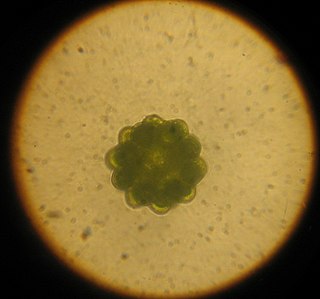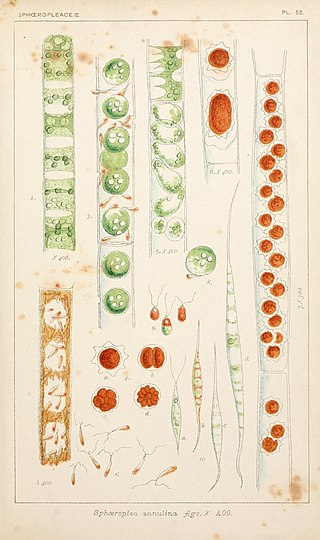
The Chlorophyceae are one of the classes of green algae, distinguished mainly on the basis of ultrastructural morphology. They are usually green due to the dominance of pigments chlorophyll a and chlorophyll b. The chloroplast may be discoid, plate-like, reticulate, cup-shaped, spiral- or ribbon-shaped in different species. Most of the members have one or more storage bodies called pyrenoids located in the chloroplast. Pyrenoids contain protein besides starch. Some green algae may store food in the form of oil droplets. They usually have a cell wall made up of an inner layer of cellulose and outer layer of pectose.

Sphaeropleales is an order of green algae that used to be called Chlorococcales. The order includes some of the most common freshwater planktonic algae such as Scenedesmus and Pediastrum. The Sphaeropleales includes vegetatively non-motile unicellular, colonial, or filamentous taxa. They have biflagellate zoospores with flagella that are directly opposed in direction : Sphaeroplea, Atractomorpha, Neochloris, Hydrodictyon, and Pediastrum. All of these taxa have basal body core connections. Motile cells generally lack cell walls or have only a very fine layer surrounding the cell membrane. Other common characteristics include a robust vegetative cell wall, cup-shaped chloroplasts with large pyrenoids, and relatively large nuclei.

Coelastrum is a genus of green algae in the Scenedesmaceae family. It is a common component of the phytoplankton in freshwater habitats such as ponds, lakes, waterfalls, and temporary pools of water, particularly eutrophic ones. The genus has a more or less cosmopolitan distribution, although some species appear to have more restricted geographical distributions.

Selenastraceae is a family of green algae in the order Sphaeropleales. Members of this family are common components of the phytoplankton in freshwater habitats worldwide. A few species have been found in brackish and marine habitats, such as in the Baltic Sea.

Sphaeropleaceae is a family of green algae in the order Sphaeropleales.

Ankistrodesmus is a genus of green algae in the family Selenastraceae. It is one of the most common types of phytoplankton in freshwater habitats around the world.
Ankyra is a genus of green algae in the family Characiaceae. This genus of algae is closely related to Atractomorpha and Sphaeroplea. They are found in stagnant waters.
Dictyochloris is a genus of green algae in the class Chlorophyceae. It is the sole genus of the family Dictyochloridaceae. It is commonly found in terrestrial and subaerial habitats.

Dictyosphaerium is a genus of green algae, in the family Chlorellaceae. It occurs in freshwater habitats around the world and is planktonic.

Dimorphococcus is a genus of fresh water green algae in the family Scenedesmaceae. It is found as a component of the phytoplankton of freshwater ponds, lakes, and peat bogs. It is widespread, but usually not very common.

Golenkinia is a genus of green algae first described in 1894 by Robert Chodat. The genus is named for the Russian phycologist Mikhail Iljitsch Golenkin. Golenkinia species live in fresh water and are found around the world.
Planktosphaeria is a genus of green algae, specifically of the Chlorophyceae. It was first described by the phycologist Gilbert Morgan Smith in 1918, with Planktosphaeria gelatinosa as its type species. Species of Planktosphaeria are commonly found in freshwater plankton around the world.
Podohedriella is a genus of green algae in the family Selenastraceae. It is found in freshwater habitats or on damp wood.
Pseudomuriella is a genus of green algae, specifically of the class Chlorophyceae. It is the sole genus of the family Pseudomuriellaceae. It is a terrestrial alga that inhabits soils.

Selenastrum is a genus of green algae in the family Selenastraceae. It is common in freshwater habitats around the world. Most species prefer temperate or warm-temperate waters.

Tetraedron is a genus of green algae in the family Hydrodictyaceae. It may also be spelled as Tetraëdron.

Tetrastrum is a genus of green algae (Chlorophyta). It is a common component of the phytoplankton of freshwater habitats, particularly eutrophic and alkaline waters.

Characiaceae is a family of green algae in the order Sphaeropleales. It contains epiphytic or planktonic algae that are unicellular or colonial. The cells are heteropolar, with basal and apical ends having different shapes. The daughter cells are often retained in the cell wall of the old mother cell, whose cell wall becomes gelatinized.
Bracteamorpha is a genus of green algae in the order Sphaeropleales, and is the only genus in the family Bracteamorphaceae. It contains a single species, Bracteamorpha trainorii.
Chlorolobion, sometimes spelled Chlorolobium, is a genus of algae belonging to the family Selenastraceae. The species of this genus are found in freshwater habitats in Europe and America.













